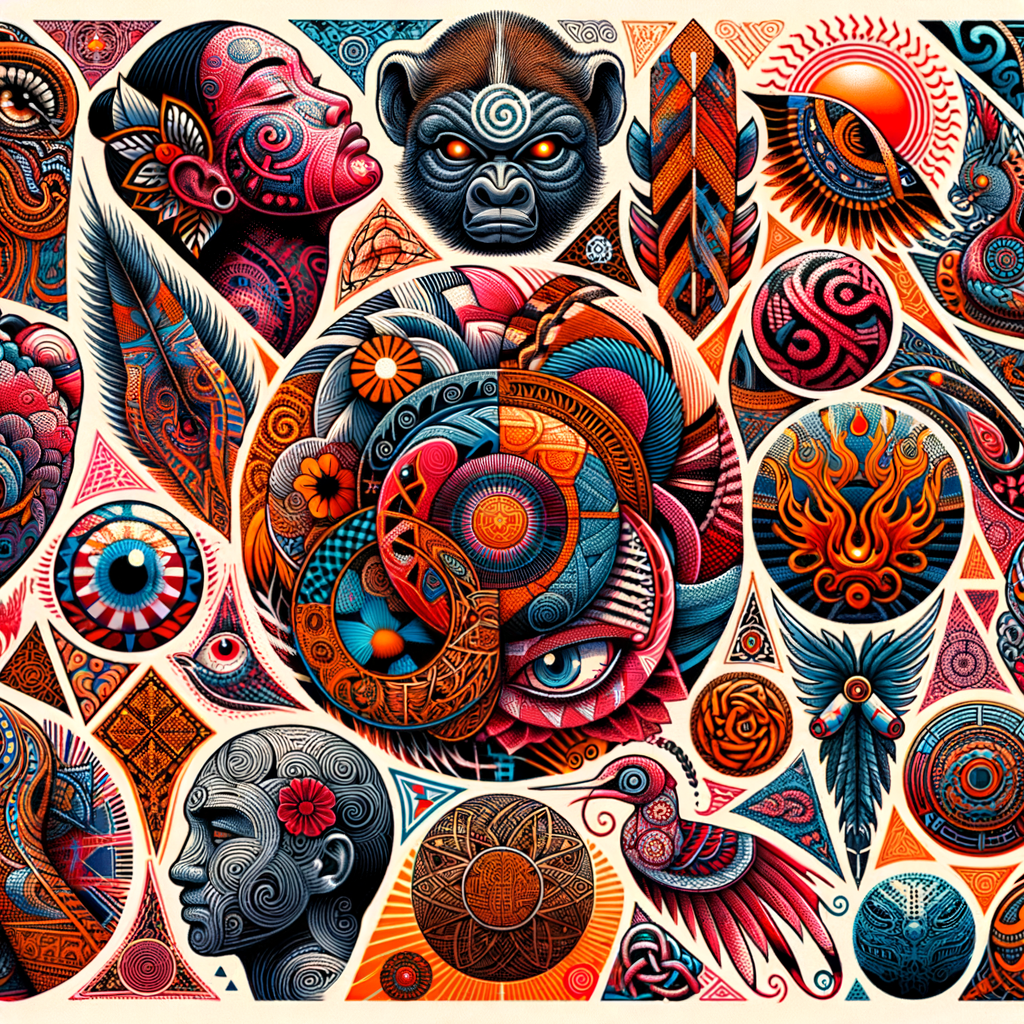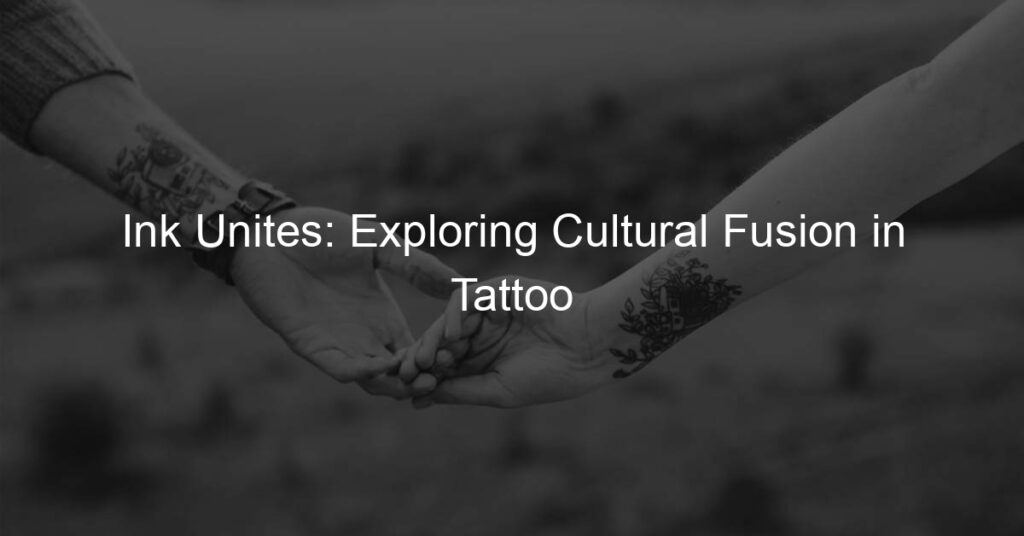
Introduction to Cultural Tattoo Art
When we think of tattoos, we often imagine intricate designs inked on skin. But did you know that tattoos are more than just body art? They are a form of cultural expression, carrying deep meanings and historical significance. In this section, we will delve into the fascinating world of cultural tattoo art.
- Definition of Cultural Tattoo Art
- Historical Background
- Global Tattoo Trends
Cultural tattoo art refers to the practice of creating tattoos that are deeply rooted in a particular culture’s traditions and beliefs. These tattoos often carry symbolic meanings, telling stories of heritage, identity, and community. They are not just decorative; they are a way of wearing one’s history and culture on one’s skin.
Tattooing has been a part of human culture for thousands of years. The oldest known tattooed human skin to date is found on the body of Ötzi the Iceman, dating from between 3370 and 3100 BC. Different cultures have used tattoos for various purposes, such as rites of passage, marks of status, or even as a form of punishment. Over time, the art of tattooing has evolved, but its cultural significance remains.
Today, tattoo art has become a global phenomenon. While the traditional cultural tattoo art forms continue to thrive, new trends are also emerging. These include fusion styles that blend elements from different cultures, minimalist designs, and tattoos inspired by popular culture. Despite these trends, the essence of tattoo art as a form of cultural expression remains intact.
As we explore the world of cultural tattoo art, we will discover how this ancient practice has evolved over time, adapting to the changing trends while preserving its cultural roots. Whether you are a tattoo enthusiast or simply curious about this form of art, we invite you to join us on this fascinating journey.
Fusion Tattoo Styles: A Blend of Cultures
In the world of tattoo art, fusion styles have emerged as a unique and captivating trend. They represent a blend of different cultures, creating a beautiful and meaningful expression of diversity.
Understanding Fusion Tattoo Styles
Fusion tattoo styles are a combination of different tattoo art forms from various cultures. They are a testament to the artist’s creativity and the wearer’s appreciation for diverse cultures. Let’s delve deeper into this fascinating concept.
- Concept of Fusion in Tattoo Art
- Popular Fusion Tattoo Styles
- Japanese and American Traditional: This style combines the bold lines and vibrant colors of American traditional tattoos with the intricate details and symbolism of Japanese tattoo art.
- Polynesian and Tribal: This fusion style merges the geometric patterns of tribal tattoos with the symbolic motifs of Polynesian tattoo art.
- Realism and Abstract: This style blends the lifelike details of realism tattoos with the creative freedom of abstract tattoo art.
Fusion in tattoo art is all about blending different tattoo styles from various cultures into a single design. This concept is not just about merging designs; it’s about understanding the cultural significance of each element and presenting them in a respectful and harmonious manner. It’s a beautiful way to celebrate cultural diversity and unity.
There are several popular fusion tattoo styles that have gained popularity due to their unique appeal. Some of these include:
These are just a few examples. The possibilities in fusion tattoo styles are endless, allowing for a unique and personal expression of one’s appreciation for diverse cultures.
Understanding and appreciating fusion tattoo styles can deepen our appreciation for the art form and the diverse cultures it represents. It’s a testament to the beauty of diversity and the unity it can inspire.
Case Studies: Fusion Tattoo Styles
Now that we’ve understood the concept of fusion tattoo styles, let’s delve deeper into some real-life examples. These case studies will give you a better understanding of how artists blend different cultural influences to create unique tattoo designs.
-
Case Study 1: The Japanese-Irish Fusion
One of the most interesting fusion tattoo styles is the blend of Japanese and Irish cultures. This style often combines the intricate knotwork of Celtic art with the bold, vibrant imagery of traditional Japanese tattoos. Let’s take a look at a specific example.
John, a tattoo artist from New York, created a stunning piece that perfectly embodies this fusion style. He designed a tattoo featuring a Celtic cross entwined with a Japanese dragon. The dragon, a symbol of strength and wisdom in Japanese culture, was drawn with the bold lines and vibrant colors typical of Japanese tattoo art. The Celtic cross, a symbol of faith and unity in Irish culture, was intricately designed with Celtic knotwork.
This fusion of two distinct cultures resulted in a unique and visually striking tattoo that tells a story of cultural harmony.
-
Case Study 2: The Polynesian-Maori Blend
Another fascinating fusion tattoo style is the blend of Polynesian and Maori cultures. This style often combines the geometric patterns of Polynesian tattoos with the spiral motifs of Maori tattoos.
Consider the example of Lisa, a tattoo artist from Australia. She designed a tattoo that beautifully blends these two cultural styles. The tattoo features a Polynesian turtle, a symbol of longevity and peace, surrounded by Maori spiral motifs, which represent life, growth, and new beginnings.
This fusion of Polynesian and Maori cultures resulted in a unique tattoo that not only looks visually appealing but also carries a deep cultural significance.
These case studies demonstrate how fusion tattoo styles can create unique and meaningful pieces of art. By blending different cultural influences, tattoo artists can tell a story of cultural unity and respect, while also creating visually stunning designs.
International Tattoo Designs: A Global Perspective
As we delve into the world of tattoo art, we find that it is as diverse and rich as the cultures that birthed it. Each region has its unique style, symbolism, and technique that reflect its history, beliefs, and traditions. This section aims to explore and appreciate the beauty of international tattoo designs.
Exploring International Tattoo Designs
Let’s embark on a journey to understand the artistry and significance of tattoos from various cultures and the key insights we can draw from them.
- Tattoo Art from Different Cultures
- Key Takeaways from International Tattoo Designs
From the intricate tribal tattoos of Polynesia to the vibrant Yakuza tattoos of Japan, each culture brings a unique flavor to the art of tattooing. In the West, tattoos were initially seen as a mark of rebellion but have now become a form of self-expression and individuality. In contrast, in many Eastern cultures, tattoos often carry religious or spiritual significance. For instance, in Thailand, the Sak Yant tattoos are believed to provide protection and good luck.
Exploring international tattoo designs teaches us that tattoos are more than just body art. They are a form of communication, a reflection of personal beliefs and societal values. They tell stories of identity, heritage, and even resistance. Moreover, they remind us of the shared human desire to express ourselves and connect with others, transcending geographical and cultural boundaries.
As we continue to explore the world of international tattoo designs, we will encounter more fascinating styles and stories. They will not only enrich our understanding of this art form but also inspire us to appreciate the diversity and interconnectedness of our global community.
Examples of International Tattoo Designs
Let’s take a journey around the world through the art of tattooing. Here are two examples of international tattoo designs that showcase the unique cultural influences and artistic styles from different regions.
- Japanese Irezumi:
- Polynesian Tribal:
The art of Irezumi, or traditional Japanese tattooing, has a history that spans centuries. This style often features bold colors and intricate designs of mythical creatures, nature elements, and historical figures. The full-body tattoos, also known as “suits,” are a hallmark of this style, reflecting the influence of the Edo period woodblock prints.
Originating from the islands of the South Pacific, Polynesian tribal tattoos are a form of storytelling and a symbol of status and identity. The designs are typically black and consist of geometric patterns and symbols. Each symbol has a specific meaning, and the arrangement and combination of these symbols tell a unique story about the wearer’s journey and status.
These examples illustrate how tattoo art can be a reflection of cultural heritage and personal identity. Whether it’s the bold and intricate Irezumi from Japan or the symbolic and geometric Polynesian tribal tattoos, each design tells a story that transcends borders and connects us to different cultures.
Cross-Cultural Tattoos: Bridging Cultures
In the realm of body art, cross-cultural tattoos stand as a testament to the unity and diversity of human cultures. They are a beautiful blend of different traditions, symbols, and meanings, serving as a bridge between cultures.
Understanding Cross-Cultural Tattoos
Before we delve deeper into the world of cross-cultural tattoos, it’s essential to understand what they are and how they impact global tattoo trends.
- Concept of Cross-Cultural Tattoos
- Impact of Cross-Cultural Tattoos on Global Tattoo Trends
Cross-cultural tattoos are a fusion of designs and symbols from different cultures. They are a form of body art that borrows elements from various traditions to create a unique and meaningful piece. This concept is not just about merging designs; it’s about respecting and understanding the cultures they come from. It’s about appreciating the beauty of diversity and using it as a tool to bring people closer.
Cross-cultural tattoos have significantly influenced global tattoo trends. They have opened up a world of possibilities for artists and enthusiasts alike, allowing them to explore and experiment with different styles. According to a recent survey, about 38% of people with tattoos have at least one cross-cultural design. This trend is not just about aesthetics; it’s about promoting cultural exchange and understanding. It’s about breaking down barriers and celebrating the richness of human diversity.
In conclusion, cross-cultural tattoos are more than just body art. They are a symbol of unity, diversity, and mutual respect among different cultures. They are a testament to the fact that despite our differences, we are all connected in some way.
Case Studies: Cross-Cultural Tattoos
Let’s take a closer look at two fascinating case studies that highlight the power and beauty of cross-cultural tattoos.
- Case Study 1: The Maori and Japanese Fusion
- Case Study 2: The Celtic and Native American Blend
In this case, we see a unique blend of Maori and Japanese tattoo styles. The Maori culture of New Zealand is famous for its bold, black ink patterns, while Japanese tattoo art is known for its intricate, colorful designs. A tattoo artist from Australia, fascinated by both cultures, decided to create a fusion of these two styles.
The result was a stunning piece of body art that combined the bold lines and patterns of Maori tattoos with the vibrant colors and detailed imagery of Japanese tattoos. This fusion not only created a visually striking tattoo but also served as a symbol of unity and respect between two distinct cultures.
In another case, a tattoo artist from the United States was inspired to combine elements of Celtic and Native American tattoo art. Celtic tattoos are known for their intricate knotwork and spirals, while Native American tattoos often feature animals and nature symbols.
The artist created a design that incorporated a Celtic knotwork border with a Native American eagle in the center. The tattoo was a hit, with many people appreciating the blend of cultures and the powerful symbolism of unity and strength it represented.
These case studies show how cross-cultural tattoos can serve as a bridge between different cultures, promoting understanding and respect. They also highlight the endless possibilities for creativity and expression in the world of tattoo art.
Tattoo Art Inspiration: Drawing from Diverse Cultures
When it comes to tattoo art, inspiration can be drawn from a multitude of sources. One of the richest sources of inspiration is the diverse cultures of the world. Each culture has its unique symbols, patterns, and styles that can be a great source of inspiration for tattoo art.
Exploring Tattoo Art Inspiration
Exploring the world of tattoo art is like embarking on a journey around the globe. From the intricate patterns of Polynesian tribal tattoos to the vibrant colors of Mexican folk art tattoos, there is a wealth of inspiration to be found in the diverse cultures of the world.
- Role of Culture in Tattoo Art Inspiration
- Examples of Tattoo Art Inspired by Different Cultures
Culture plays a significant role in tattoo art inspiration. It provides a wealth of symbols, patterns, and styles that can be used to create unique and meaningful tattoos. For instance, the Maori people of New Zealand have a rich tradition of tattooing, known as Ta Moko, which is deeply rooted in their culture and identity. Similarly, Japanese tattoo art, known as Irezumi, is renowned for its intricate designs and deep symbolism, drawing heavily from Japanese folklore and mythology.
There are countless examples of tattoo art inspired by different cultures. For instance, Celtic tattoos, with their intricate knotwork and spirals, are inspired by the art and mythology of the ancient Celts. Native American tattoos often feature symbols like feathers and dream catchers, drawing inspiration from Native American culture and spirituality. Polynesian tattoos, known for their bold geometric patterns, are deeply rooted in Polynesian culture and tradition. And these are just a few examples – the world of tattoo art is as diverse as the cultures it draws inspiration from.
In conclusion, the diverse cultures of the world offer a rich source of inspiration for tattoo art. By exploring these cultures and their unique symbols, patterns, and styles, you can find inspiration for your own unique tattoo design.
Cultural Influence in Tattoo Art
When we think about tattoos, we often see them as a form of personal expression. However, it’s important to understand that the art of tattooing is deeply rooted in various cultures around the world. The influence of different cultures on tattoo art is significant and fascinating to explore.
Understanding Cultural Influence in Tattoo Art
Understanding the cultural influence in tattoo art means recognizing the role of different cultures in shaping the designs, techniques, and meanings behind tattoos. It’s about appreciating the rich history and diversity that has led to the wide range of tattoo styles we see today. Let’s delve into the role of cultural influence in tattoo art and look at some examples.
- Role of Cultural Influence in Tattoo Art
- Examples of Cultural Influence in Tattoo Art
Cultural influence plays a pivotal role in tattoo art. It shapes the symbols, designs, and techniques used in tattoos. For instance, the intricate patterns in Polynesian tattoos are a reflection of their rich cultural heritage. Similarly, the bold lines and vivid colors in traditional Japanese tattoos represent their cultural aesthetics. The cultural influence in tattoo art is not just about aesthetics; it also carries deep meanings and stories from the culture it originates from.
There are countless examples of cultural influence in tattoo art. Let’s look at a few:
1. Maori Tattoos: Originating from the Maori people of New Zealand, these tattoos, known as Ta Moko, are more than just body art. They represent a person’s identity, status, and ancestry in the Maori culture.
2. Japanese Irezumi: This traditional Japanese tattoo style is known for its bold colors, intricate designs, and large-scale imagery. It often features cultural symbols like koi fish, dragons, and cherry blossoms.
3. Celtic Tattoos: These tattoos feature intricate knotwork, spirals, and complex geometric patterns. They are inspired by the art and mythology of the ancient Celtic culture.
In conclusion, the cultural influence in tattoo art is profound and diverse. It adds depth and meaning to the art of tattooing, making it more than just a form of body modification. It’s a way of carrying and expressing cultural heritage and identity.
Fusion of Cultures in Tattoo Art
In the world of tattoo art, the fusion of cultures is a fascinating phenomenon. This fusion not only creates unique and stunning designs but also bridges gaps between different cultures, fostering understanding and appreciation.
Exploring the Fusion of Cultures in Tattoo Art
Let’s delve into the concept of cultural fusion in tattoo art and its impact on tattoo art styles.
- Concept of Cultural Fusion in Tattoo Art
- Impact of Cultural Fusion on Tattoo Art Styles
Cultural fusion in tattoo art refers to the blending of elements from different cultures to create a new, unique design. It’s like a melting pot where different cultural symbols, motifs, and styles come together. For instance, a tattoo might combine Japanese koi fish with Polynesian tribal patterns, or a Celtic knot with an Indian mandala. This fusion not only results in visually striking designs but also symbolizes the unity and harmony of diverse cultures.
The impact of cultural fusion on tattoo art styles is profound. It has led to the emergence of new styles that are a blend of traditional and modern, eastern and western, tribal and contemporary. For example, the ‘Neo-tribal’ style combines elements from indigenous cultures with modern aesthetics. Similarly, ‘Blackwork’ style often incorporates patterns from different cultures like Maori, Indian, and Thai.
Moreover, cultural fusion in tattoo art has expanded the creative boundaries for tattoo artists, giving them a broader palette to work with. It has also enriched the tattoo culture by adding depth and meaning to the designs. A fusion tattoo is not just a piece of art; it’s a story, a symbol of unity in diversity.
In conclusion, the fusion of cultures in tattoo art is a beautiful testament to the power of art in bringing people together. It’s a celebration of diversity, a tribute to our shared humanity. So next time you see a fusion tattoo, remember, it’s more than just ink on skin; it’s a symbol of unity in diversity.






